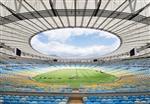Plastics the hidden winners of the championship: match balls, referees’ whistles, goal nets, corner flags, red and yellow cards, shin pads, football boots, jerseys – all are made of plastics!

Plastics the hidden winners of the championship: match balls, referees’ whistles, goal nets, corner flags, red and yellow cards, shin pads, football boots, jerseys – all are made of plastics!

The official match ball of the 2014 World Cup – has a unique symmetry of six identical propeller-shaped polyurethane panels being thermally bonded together, alongside a different surface structure that will provide improved grip, touch, stability and aerodynamics on the pitch. The ball weighs 437 grams and has a circumference of 69 cm. It offers a water absorption rate of 0.2%, meaning it can retain its shape, size and weight even in the rain. It is worth mentioning that the brazuca ball had to stand high speed spin cycles in a washing machine as well as robot kicks of up to 160 km/h to test its waterproofness and durability. The name "brazuca”, meaning the Brazilian way of life, was chosen by over 1 million football fans in September 2012.
© Bayer MaterialScience
Photo: © Adidas

2014 World Cup has 3 primary kits sponsors that cover a majority of the teams. One of the sponsors produced new lightweight jerseys that use a highly breathable fabric to provide improved ventilation. In addition to moisture and sweat management, it resists pilling (bunching and breaking of fibres) and is anti-microbial. The brand owner claims that its jerseys are also around 40 percent lighter than the ones used in 2012's Euro Cup - the weight of the new jersey is 100 grams, down from 166 grams. That might not sound like much, but when the footballers are pushing themselves to the limit for 90 minutes, it can make a big difference. Another sponsor provides jerseys which make use of a combination of cotton and recycled polymer. The shorts feature 100 percent recycled polymer, while the shirts 96 percent and the stockings 78 percent. Recycled plastic bottles are used to make the polymer - on average, 18 bottles are used to make one kit. New generation jerseys: a combination of wearing comfort and low environmental impact!
Photo: © Nike

The World Cup in Brazil featured many new cleats from major brands. These revolutionary football shoes provided unique comfort to international football superstars, allowing for better feel and control of the ball in all conditions: wet or dry. The high tech materials used to make these shoes added protection, stability and power as well as the ability to cut and accelerate. Today, a state-of-the-art football shoe consists of more than 70 percent plastics, weighs only 200 grams, is tear-proof, shatter-proof, water-repellent, and yet breathable. Also the studs are made of special plastics. They further reduce the weight of the cleats, adjust to ground conditions, and keep their shape in all kinds of weather. The latest trend is knitted football shoes that adjust to the players’ feet like a second skin, making them feel like playing barefoot. To this end, sock-like upper parts are connected with a thin, light sole made of high-performance plastics. High-quality elastomers at the cap and heel absorb shocks. This new shoe generation is lighter and more flexible, and enables better ball control and higher wearing comfort, without compromising the protecting and stabilising effect of a normal shoe. The upper shoe is manufactured one-piece from the heel to the toe, thus avoiding annoying seams.
Photo: © Adidas

After years of hard work, twelve state of the art stadiums have been prepared for the 2014 World Cup in Brazil. Seven new stadiums have been built, with ecological and sustainable features, ensuring the mega football event will be a successful one. Historic venues have been extensively renovated, including the Estadio do Marcana, which stands ready to stage the final showdown.
The International Football Federation set strict rules for the organisation of the World Cup tournaments. For the opening and knockout matches, a clearly defined requirements catalogue was developed, which includes e.g. the elimination of standing areas or full-scale rain protection for all spectators. Further functional requirements such as best possible view of the match and lighting of natural grass – regardless of the daytime-based or seasonal position of the sun – have driven and continue to drive new developments in the stadium architecture.
Here, high-performance lightweight plastic roofs (often made with plastic-coated membranes) allow cost-effective solutions and freedom of design. Transparent roofs ensure a natural lighting of the playing field, and its applied ultraviolet absorber layer protects against the hot sun. Some of the roofs even allow the collection of rain water, which is then used to operate the stadium toilets or to irrigate the lawn. In some of the stadiums, photovoltaic panels mounted on the roof convert sunlight into electric energy, thus covering about half of the stadium’s own energy needed. And here too, plastics is indispensable everywhere. This shows that building state-of-the-art football stadiums is no longer possible without plastics. The material of the 21st century significantly contributes to making stadiums modern landmarks of a country. At the same time, planners, architects and engineers also use plastics to face the challenges of our time: imminent climate change, rising energy costs and water shortage which had to be taken into account when building the World Cup arenas. Although it seems a long way off, sports arenas might soon serve as small power stations for renewable energies and provide private households with green power. Plastics applications can make this happen.
Photo: © Schlaich Bergermann und Partner, Marcus Bredt
